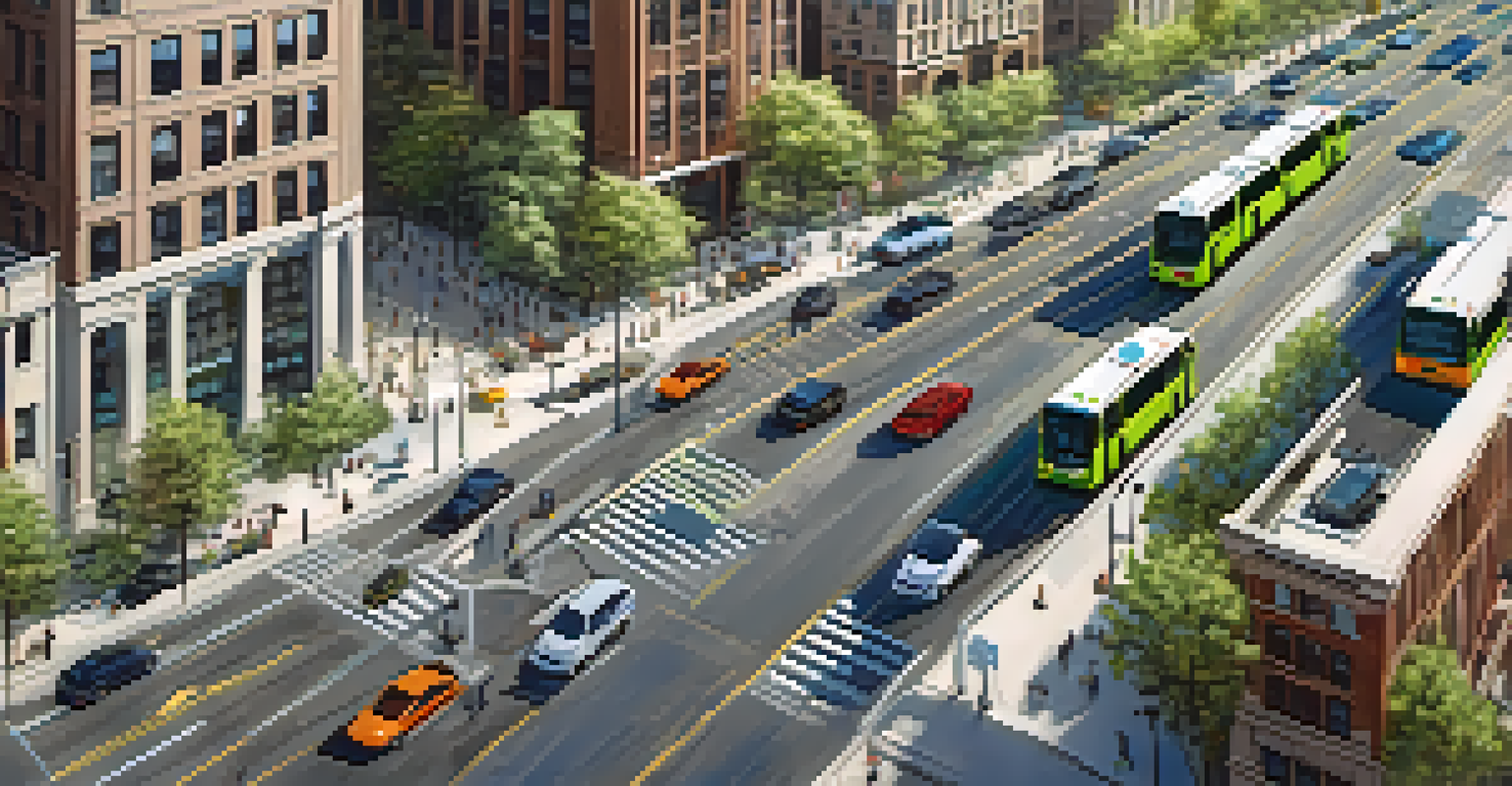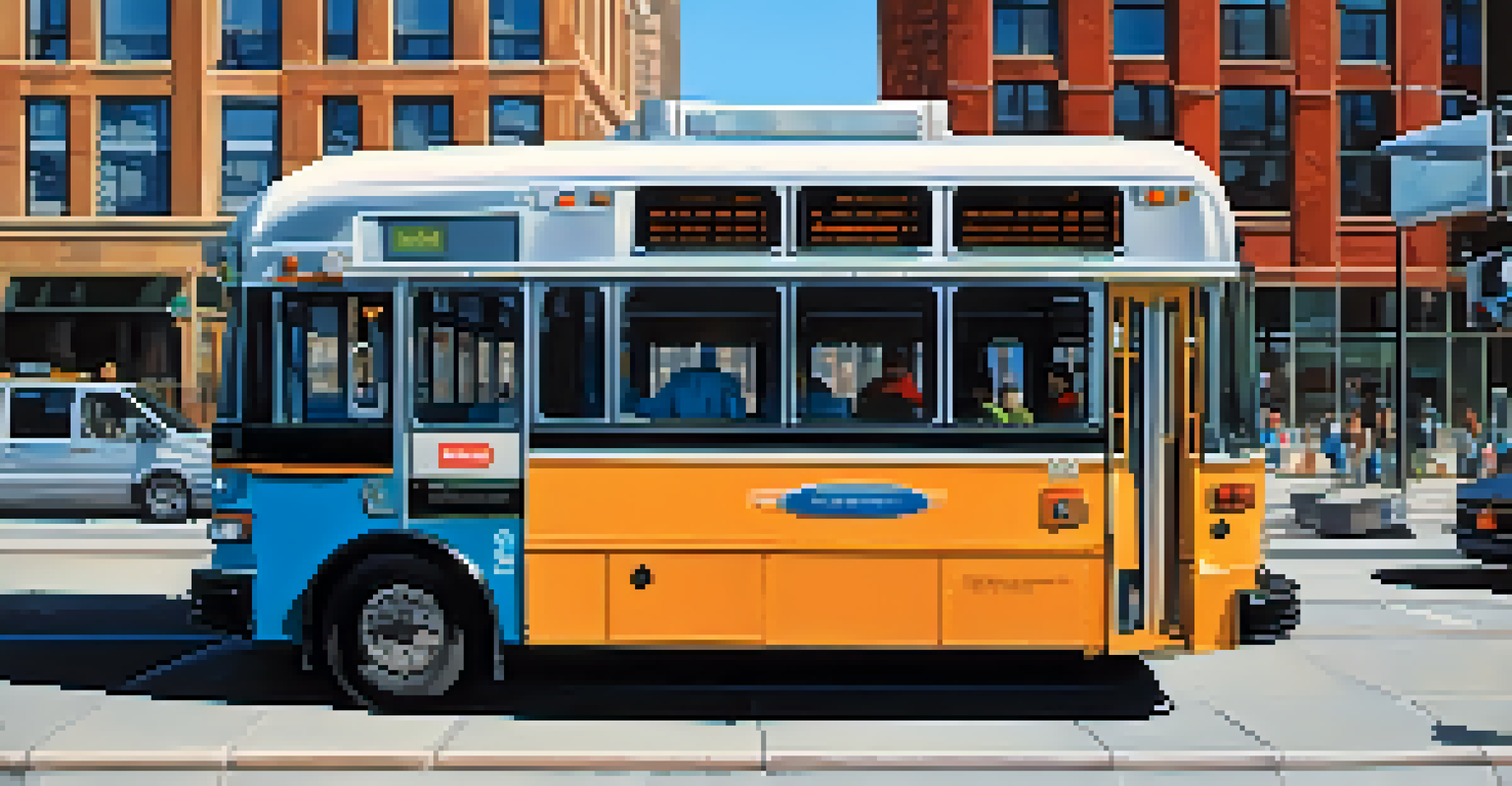Transforming Chicago's Transit: Smart Technology Innovations

Understanding the Need for Transit Innovation in Chicago
Chicago's public transit system has long been a lifeline for its residents, but as the city grows, so do the demands on this infrastructure. Aging equipment, overcrowded trains, and delays can frustrate daily commuters. With a population that relies heavily on public transport, it’s clear that innovation isn't just a luxury—it’s a necessity.
Public transport is a vital lifeline for urban residents, facilitating access to jobs, education, and services.
Many cities around the world are adopting smart technologies to enhance their transit systems, and Chicago is no exception. By leveraging data and advanced technology, the city aims to create a more efficient and user-friendly transit experience. It's not just about fixing old problems; it's about reimagining the way people move around the city.
In this context, understanding the challenges is the first step toward implementing effective solutions. By identifying pain points, Chicago can better tailor its innovations to meet the specific needs of its commuters, ensuring a smoother ride for everyone.
The Role of Data Analytics in Transit Efficiency
Data analytics is revolutionizing how cities manage their transit systems. In Chicago, data collected from various sources—like GPS tracking and ridership patterns—provides insights that help optimize routes and schedules. This means less waiting time for passengers and a more reliable service overall.

For instance, by analyzing peak travel times, the Chicago Transit Authority (CTA) can adjust train frequencies to accommodate larger crowds during rush hours. This data-driven approach not only improves the commuter experience but also helps in resource allocation, ensuring that buses and trains are where they are needed most.
Transit Innovation is Essential
As Chicago's population grows, innovative solutions are necessary to improve public transit efficiency and user experience.
Moreover, real-time data can be shared with passengers through mobile apps, allowing them to plan their journeys more effectively. Imagine knowing exactly when your train is arriving, or being alerted to delays before you even leave your house—this is the power of data analytics in action.
Integrating Mobile Technology for a Seamless Experience
Mobile technology is at the forefront of transforming how riders interact with transit services. In Chicago, apps like Ventra not only allow users to pay for fares but also provide real-time updates on their journeys. This integration simplifies the process and enhances convenience, making public transport more accessible.
Data is the new oil. It's valuable, but if unrefined, it cannot really be used.
Commuters can check train schedules, receive notifications about delays, and even track their bus’s location in real-time. This level of transparency empowers passengers, allowing them to make informed decisions about their travel plans. Moreover, it encourages the use of public transit by removing the uncertainty that often deters potential riders.
As mobile technology continues to evolve, the integration of features like mobile ticketing and contactless payments is set to further streamline the transit experience. This shift not only modernizes the rider experience but also aligns with the growing trend of cashless transactions in everyday life.
Smart Traffic Management Systems to Reduce Congestion
Traffic congestion is an ongoing challenge for urban areas, and Chicago is no stranger to this issue. Smart traffic management systems utilize sensors and cameras to monitor traffic flow and adjust signal timings accordingly. This technology not only improves vehicular movement but also enhances the efficiency of public transit vehicles on the road.
For example, prioritizing buses at traffic signals can significantly reduce travel times, making public transport a more appealing option. By minimizing delays caused by traffic, these systems contribute to a more reliable transit schedule, which is crucial for commuters who are often pressed for time.
Data Analytics Enhances Transit
Utilizing data analytics allows Chicago to optimize routes and schedules, resulting in reduced wait times and a more reliable service.
Additionally, integrating these smart systems with public transit data can provide insights into traffic patterns, helping city planners make informed decisions on infrastructure improvements. The goal is to create a cohesive transit environment that benefits all road users, ultimately leading to a more sustainable city.
Implementing Sustainable Practices in Transit Innovations
Sustainability is increasingly becoming a focal point in urban transit development. Chicago is exploring various green technologies, such as electric buses and energy-efficient train systems, to reduce its carbon footprint. These innovations not only contribute to a cleaner environment but also align with global sustainability goals.
Moreover, investing in renewable energy sources to power transit systems can further enhance sustainability efforts. By utilizing solar panels or wind energy, Chicago can decrease its reliance on fossil fuels and promote a healthier urban ecosystem. Such initiatives are not just beneficial for the planet; they can also lead to long-term cost savings for the city.
Emphasizing sustainable practices also resonates with the values of the community, encouraging more residents to choose public transport over personal vehicles. This shift can lead to reduced traffic congestion and lower emissions, creating a win-win scenario for both commuters and the environment.
Enhancing Safety and Security Through Technology
Safety is a top priority for any transit system, and Chicago is taking significant steps to enhance security through technology. The implementation of surveillance cameras on buses and trains, along with emergency communication systems, helps ensure that passengers feel secure during their journeys. This proactive approach is essential for building trust in public transportation.
Additionally, the use of advanced analytics can help identify patterns in safety incidents, allowing the CTA to address issues before they escalate. For instance, if certain routes consistently report safety concerns, targeted interventions can be made to improve the situation. This level of responsiveness not only protects passengers but also fosters a sense of community.
Sustainability in Transit Practices
Chicago is focusing on sustainable technologies, such as electric buses, to align with environmental goals and promote cleaner urban transport.
Moreover, ensuring safety through technology can attract more riders who may have previously been hesitant to use public transit. When commuters feel secure, they are more likely to choose buses and trains over personal vehicles, which contributes to a more sustainable city.
The Future of Chicago's Transit: A Vision Ahead
As Chicago continues to embrace smart technology innovations, the future of its transit system looks promising. The integration of data analytics, mobile technology, and sustainable practices sets the stage for a transformative journey. These initiatives not only address current challenges but also prepare the city for the demands of tomorrow.
Looking ahead, Chicago can serve as a model for other urban areas seeking to modernize their transit systems. By focusing on user experience and sustainability, the city is positioning itself as a pioneer in smart transit solutions. This vision isn't just about technology; it’s about creating a public transport system that aligns with the needs and values of its residents.

Ultimately, the successful transformation of Chicago's transit system will require collaboration among city officials, transit authorities, and the community. Through collective efforts, the city can ensure that its public transport evolves into a system that is efficient, reliable, and accessible for all.